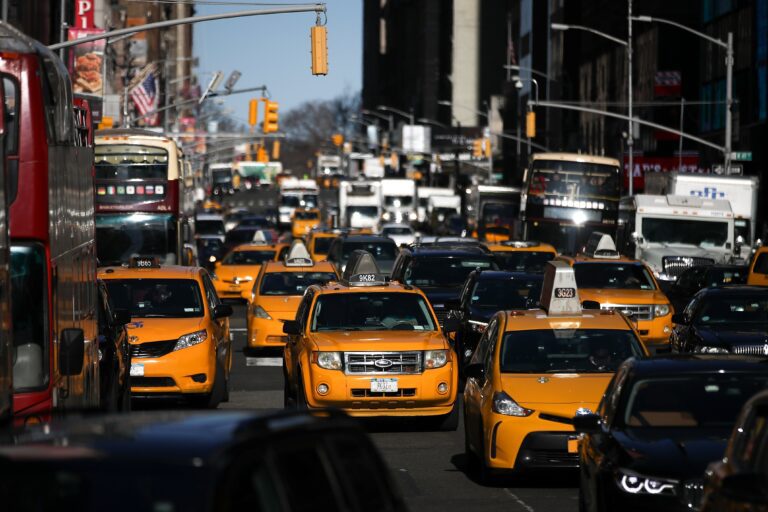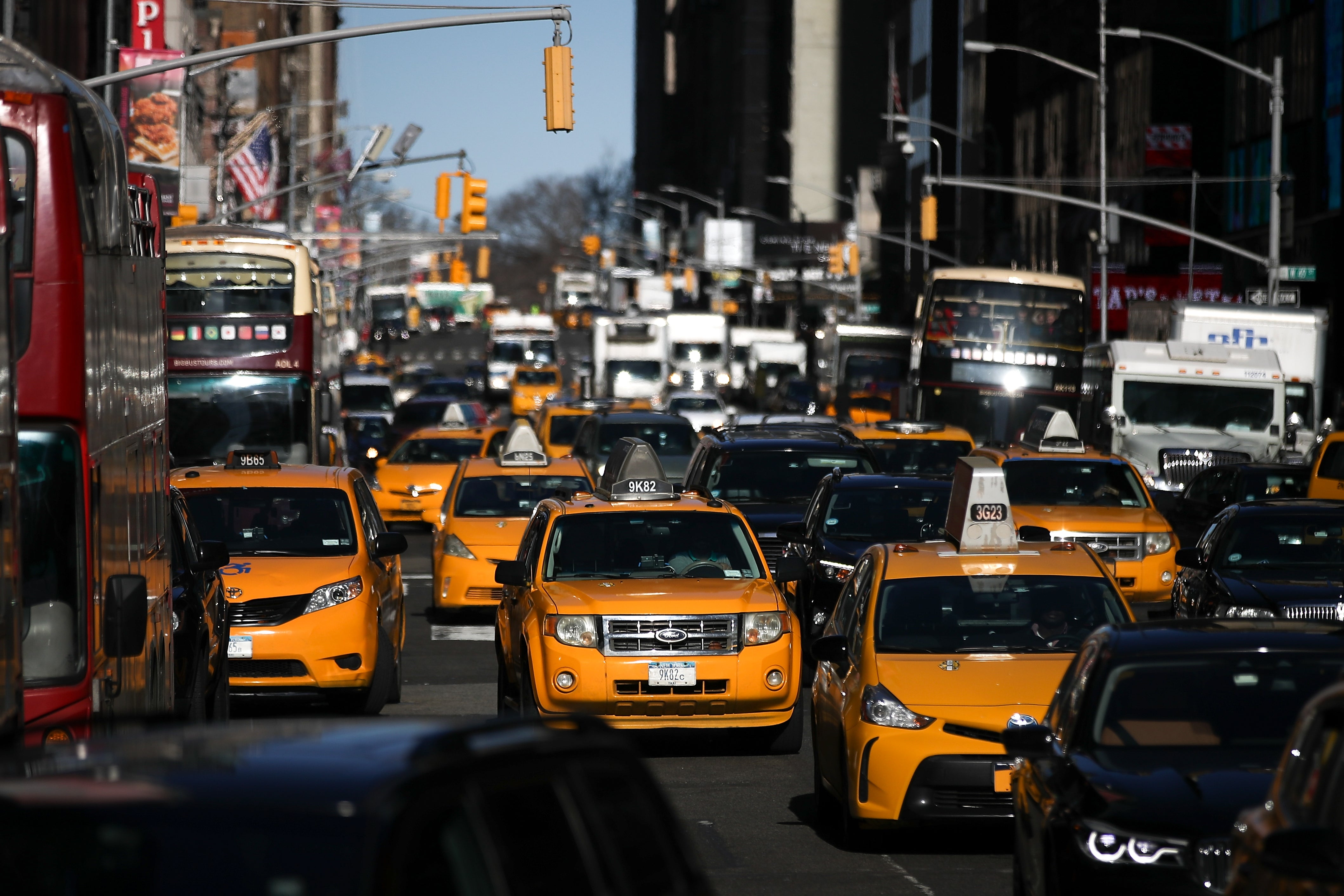
[ad_1]

CLIMATEWIRE | WEST 58TH STREET, Manhattan — Nearly a million vehicles enter the southern half of Manhattan every day, pumping tons of carbon into the air while crawling at a jogger’s speed.
But in a few months, those numbers will plummet when New York City’s transit agency starts charging motor vehicles as much as $36 to enter midtown or lower Manhattan in the nation’s first use of congestion pricing.
New York’s long-stalled effort to restrict motor vehicles in one of the most congested parts of the nation could mark a new phase in U.S. efforts to reduce planet-warming emissions.
Congestion pricing is the best government policy by far to slash tailpipe emissions — better than banning the sale of gas-powered cars, said Joshua Schank, a managing principal at InfraStrategies, a transportation consulting firm.
“When it comes to emissions reduction, all the other policies including transitioning to electric fleet and building more transit pale in comparison,” said Schank, who led Los Angeles County’s 2019 study of the policy as chief innovation officer of the county transit agency.
Electric vehicles contribute to carbon pollution by using electricity generated from fossil fuels and batteries built through energy-intensive mining processes, Schank said. New transit routes can lead people to stop driving, but as roads become less congested, personal vehicle use returns to previous levels.
“You have to price the roads,” Schank said.
New York City will cut emissions within weeks by creating a financial incentive for drivers to take public transit, ride bikes or walk, Schank said. The city will use money collected from congestion pricing — projected to be at least $1 billion a year — to build new subway lines and establish new bus routes.
Yet opposition lingers to congestion pricing, initially proposed in 2007, from residents and officials in New Jersey, Long Island and New York’s four outer boroughs.
New Jersey is suing the U.S. Transportation Department for approving the New York plan, asking a federal judge in Newark to block the measure and order a new environmental review.
The state argues that a DOT-approved environmental assessment, nearing 1,000 pages, fails to acknowledge potential increases in traffic on Jersey roads from drivers detouring to avoid the new tolls.
The mayor of Fort Lee, home to the New Jersey side of the George Washington Bridge, filed a federal class-action suit in November against the Metropolitan Transportation Authority on behalf of Bergen County officials.
The lawsuit seeks money for the additional vehicle emissions that the county expects to face as motorists, avoiding the congestion tolls, drive through northern New Jersey instead of across southern Manhattan to reach Brooklyn or Queens.
The lawsuits were filed after DOT declared that New Jersey would face no significant environmental impact from the New York plan. The DOT analysis found that new tolls would cause less than a 1 percent increase in vehicle travel in Bergen County, in New Jersey’s northeastern corner.
The congestion pricing plan has drawn support from climate activists and a variety of groups that stand to benefit. Disability rights activists support the increased funding for public transit. Ride-hailing companies such as Uber and Lyft, which already pay a congestion fee, have long supported charging taxicabs and other vehicles similar tolls.
London saw huge emissions drop
Transportation is the largest source of carbon pollution in the U.S., accounting for 29 percent of annual U.S. greenhouse gas emissions, according to EPA. Tailpipe exhaust from cars and trucks generates 81 percent of transportation emissions, which makes reducing driving one of the best ways to decrease planet-warming gases, Schank said.
When London started to charge vehicles entering its downtown in 2003, the United Kingdom capital saw a 20 percent drop in carbon emissions from transportation in less than a year, according to a study published in 2005. More Londoners walked, took transit and rode bicycles.
If roadways have no toll, people choose to drive regardless of how important the trip is, said Carter Rubin, a senior transportation lead at the Natural Resources Defense Council. Major U.S. cities suffer from chronic congestion and high emissions because drivers do not pay for carbon they emit or for the space they use on roads, Rubin said.
“People respond to free goods by getting in line and waiting,” Rubin said.
New York’s new tolls are projected to reduce the number of cars entering Midtown and Lower Manhattan by 17 percent, according to the New York transit agency. Roughly 900,000 vehicles enter the congestion zone in Manhattan every weekday.
The standard charge will be $15 for cars entering the congestion zone either through Manhattan or by bridge or tunnel from Brooklyn, Queens or New Jersey.
Moving vans and box trucks will pay $24, while trailer trucks will be charged $36 during those times. Taxis, ride-booking vehicles such as Ubers and motorcycles will pay between $1.25 and $7.50.
The new charges will be in addition to the tolls of $7 to $15 that motorists pay to enter Lower or Midtown Manhattan by tunnel.
Cameras, illuminators and antennas will be installed on all bridges, tunnels and avenues that cross 60th Street to scan license plates and E-ZPass transponders to charge drivers entering the congestion zone.
The architects of the New York plan hope that new tolls improve traffic flow in Manhattan, where cars crawl at an average speed of 7 miles per hour.
At noon on a recent Tuesday, vehicles traveling east on 59th Street clogged the intersection at Fifth Avenue near Central Park. Drivers honked and yelled at taxis and delivery trucks blocking the intersection as they fought to merge onto a single open lane.
“A lot of people will still drive no matter what — the city is busier than ever,” Rich Correa, a Lower Manhattan resident and an air conditioner technician, said as he stood at the corner of 58th Street and Sixth Avenue. “I don’t think the new toll is going to change anything.”
Public opposition to congestion pricing remains a tough political barrier, especially in U.S. cities whose residents depend heavily on driving, said Adie Tomer, a senior fellow at the Brookings Institution’s Metropolitan Policy Program.
Los Angeles County delayed its congestion pricing study by a year in 2018 because officials worried about stirring opposition ahead of state and local elections. The study is currently underway.
Boston; Los Angeles; San Francisco; Seattle; and Portland, Oregon, have expressed interest in congestion pricing.
‘Other cities are definitely watching’
New York first tried to adopt congestion pricing in 2007, when then-Mayor Michael Bloomberg included the measure in an Earth Day policy proposal. The initiative passed the New York City Council but died in the state Legislature, where Democrats in the city’s suburbs and outer boroughs blocked the measure.
Congestion pricing requires both federal and state approval as some roads in Manhattan receive funds from Washington and Albany, N.Y., for construction and maintenance.
The plan was revived in 2019 when the city’s century-old subway system faced a $510 million budget deficit that led to frequent delays and service cuts. To fix the system riddled with decrepit signals and rail cars, then-New York Gov. Andrew Cuomo and then-Mayor Bill de Blasio agreed in February 2019 to charge drivers entering the lower half of Manhattan.
Within a month, the New York Legislature approved congestion pricing as part of the state budget. Support was fueled by a newly elected batch of younger, left-leaning Democrats who themselves are transit riders.
New York could embolden other U.S. cities to implement congestion pricing, experts say. The New York example will show that congestion pricing mainly benefits drivers who can enjoy “a Sunday morning feel” on city streets throughout the week, said Rubin of NRDC.
In Sweden, before Stockholm adopted a pilot program for congestion pricing in 2006, many residents and businesses protested the idea. But the program was so successful in reducing traffic that many initial critics helped pass the referendum to make congestion pricing permanent in 2007.
Rubin said the opposition in New York will wane once congestion pricing starts.
“If you are a plumber trying to make one more house call during the day, and if you can pay a fee to save half an hour and then make $100, that’s a really good deal,” Rubin said.
Congestion pricing in New York City can serve as a testbed for cities across the U.S., which often wait for a successful model to emerge before moving ahead with an untried policy, Tomer of Brookings said.
“We are laying the groundwork, and other cities are definitely watching,” said Mary Barber, the director of New York and New Jersey at the Environmental Defense Fund.
Reduced congestion means individual automobiles emit less greenhouse gas because they move more efficiently.
In London, congestion alone generates 15 percent of the city’s total carbon pollution from vehicles, according to European traffic data firm TomTom. Driving on congested roads increases fuel consumption by 20 to 45 percent, according to a study by Belgian traffic engineers.
Congestion pricing “does what it says it is going to do,” Tomer said. “With one fee, you accomplish quite a bit.”
Reprinted from E&E News with permission from POLITICO, LLC. Copyright 2023. E&E News provides essential news for energy and environment professionals.
[ad_2]